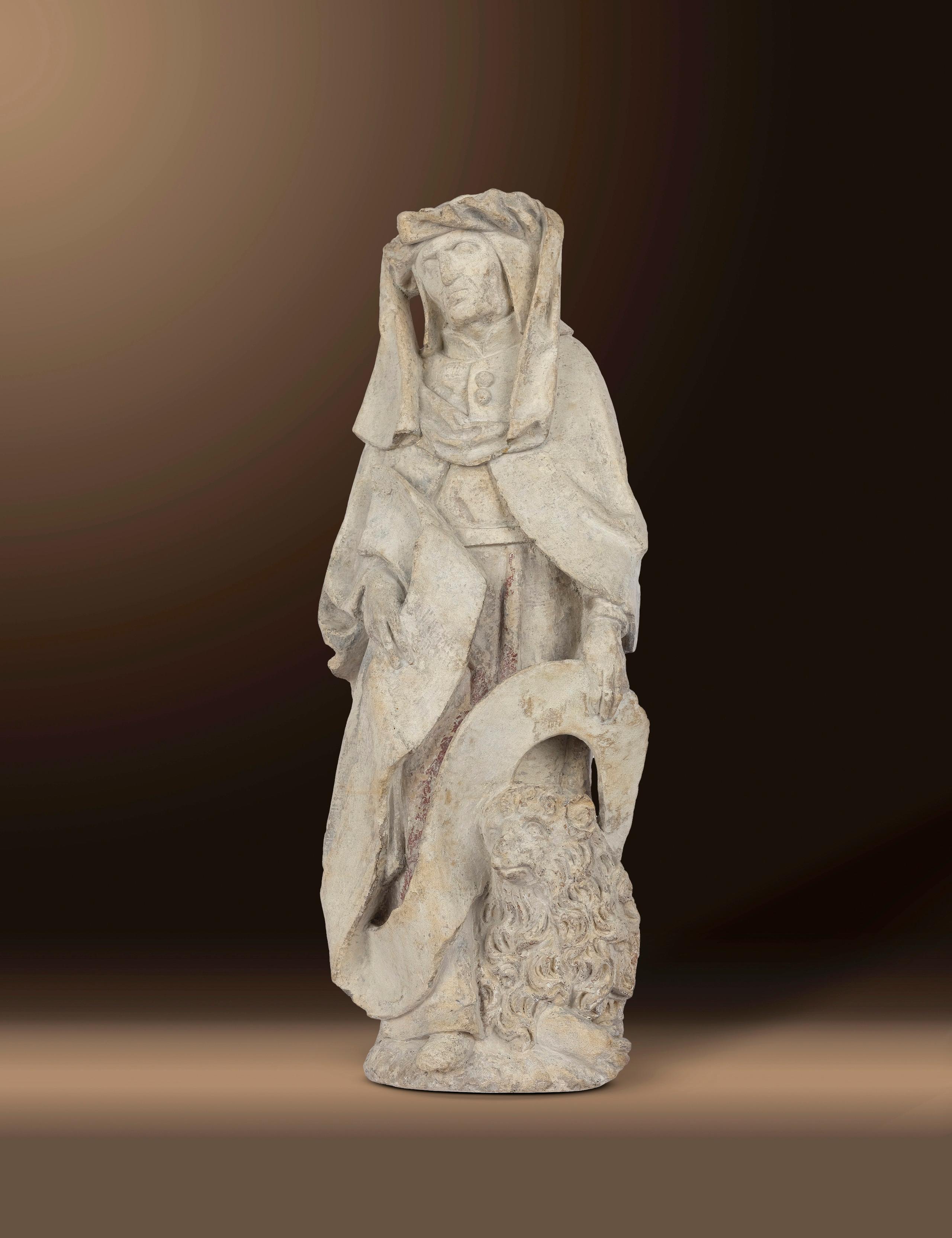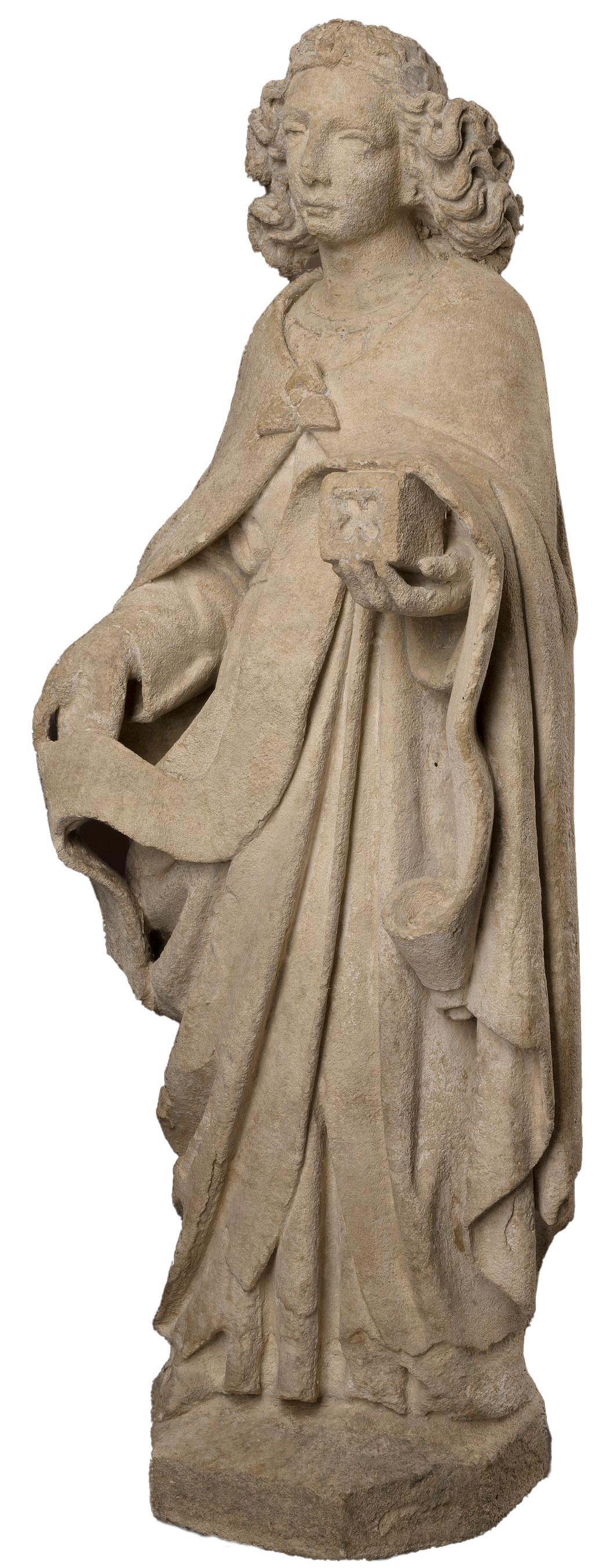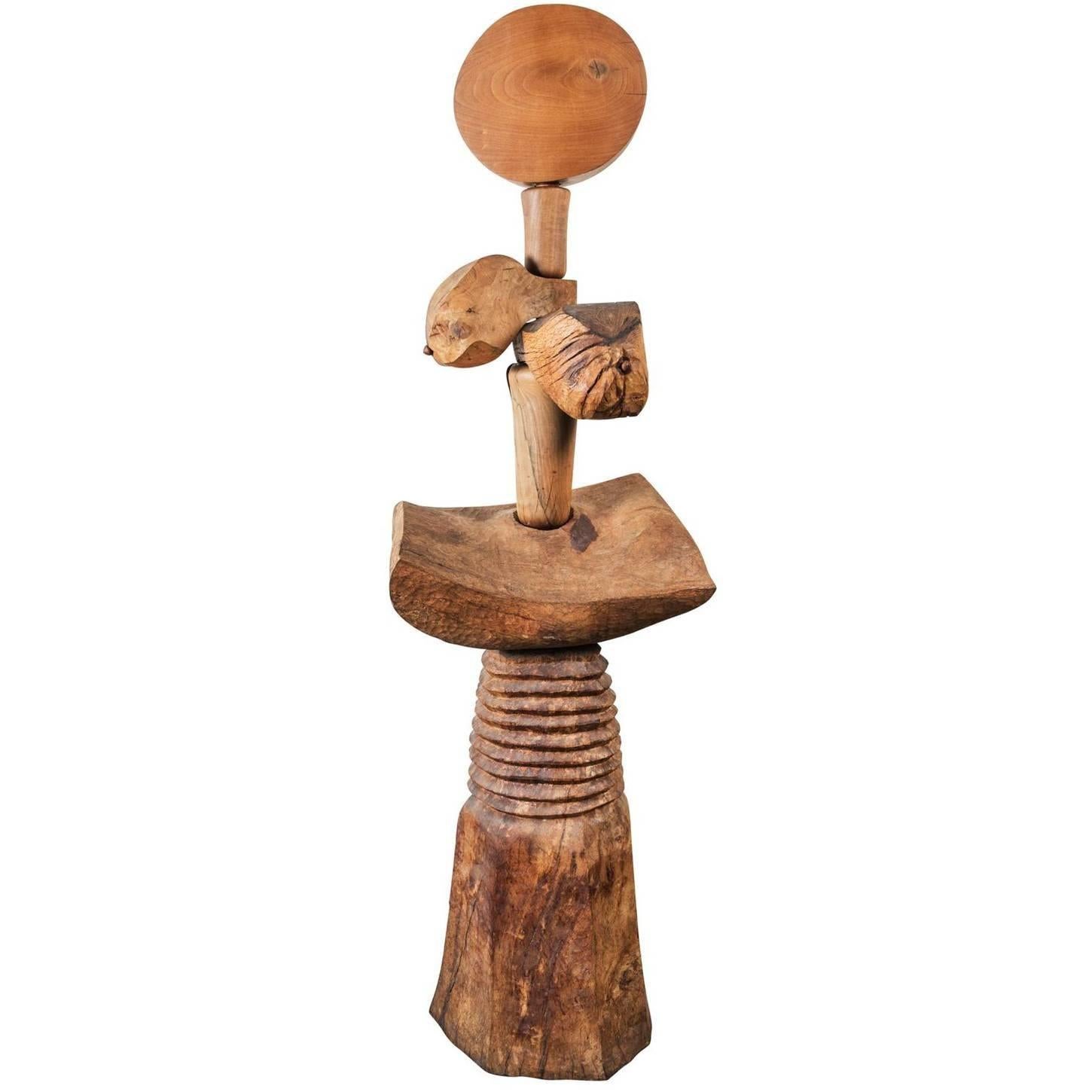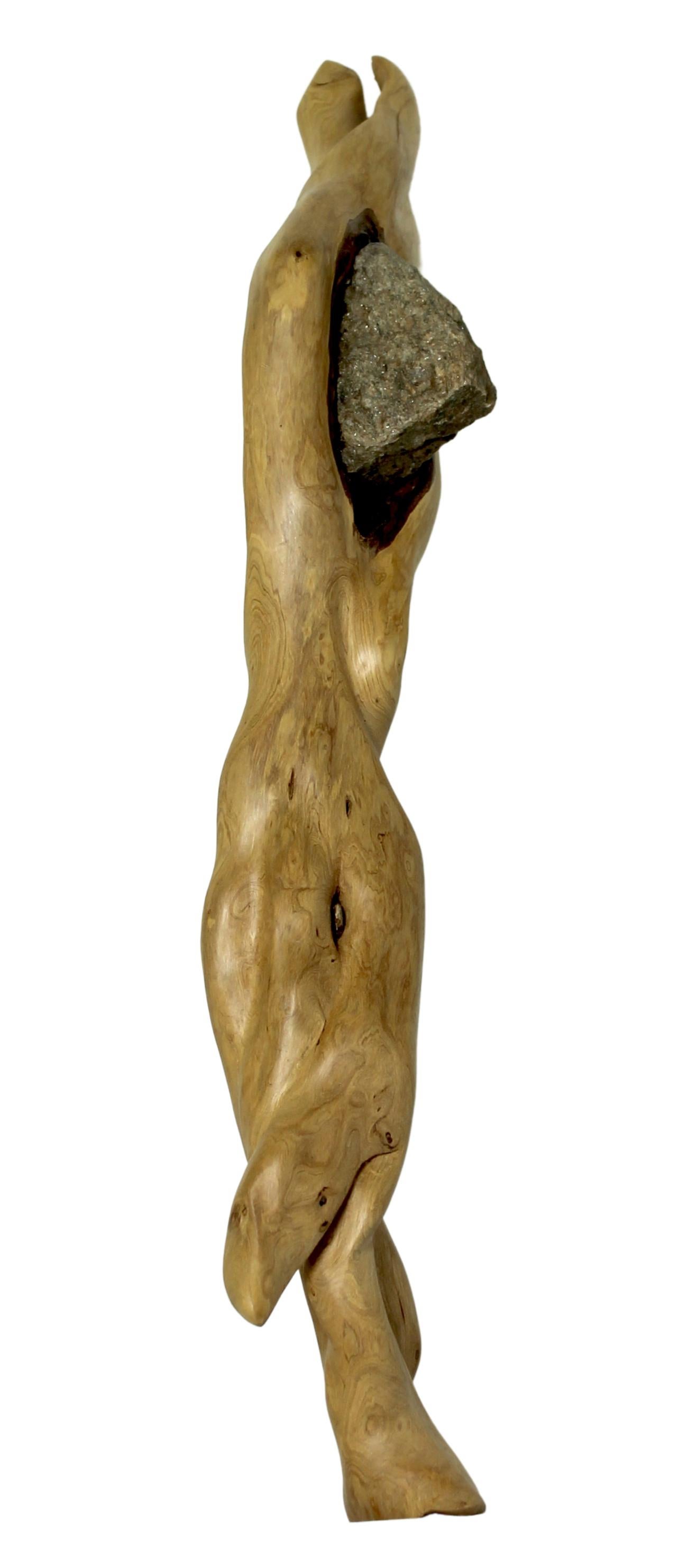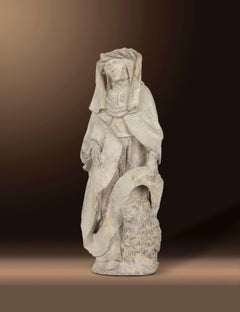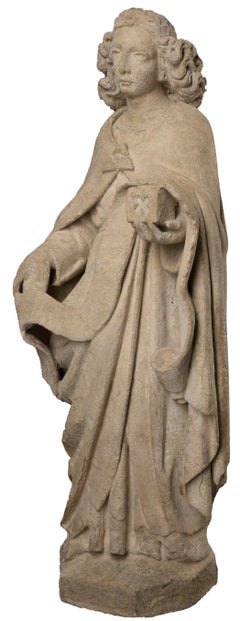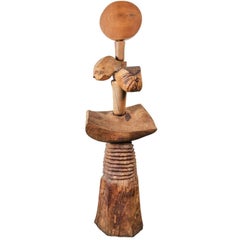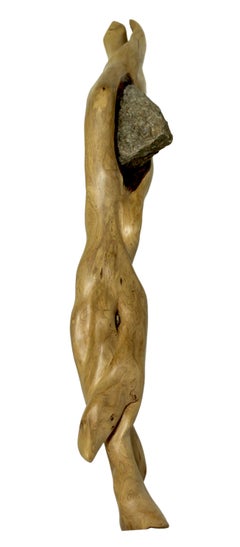Items Similar to Apotropäische Teufelsfigur
Want more images or videos?
Request additional images or videos from the seller
1 of 9
UnknownApotropäische Teufelsfigur1120/50
1120/50
$88,000
£66,909.89
€77,081.13
CA$125,112.87
A$135,976.17
CHF 71,858.09
MX$1,645,018.15
NOK 894,941.31
SEK 845,327.73
DKK 575,497.86
About the Item
APOTROPAIC DEVIL FIGURE
Romansh
South Tyrol or Grisons
Around 1120/50
Carved pine wood
Original version
Height 151 cm
This singular figure is a demonic, devil-like figure carved from part of a long beam of pine wood (length 151 cm). Presumably, this object represents an architectural element of a wooden ceiling, either in a castle, a fortress or a town hall. The Alpine figure can be stylistically assigned to the region of Grisons to South Tyrol and dates from around 1120-50. Particularly noteworthy are the old remains of the figure’s frame.
As the epitome of evil, the devil is depicted either as a single figure or within a group of demonic figures. There is no description of the devil in the Bible itself; therefore, it was up to the image carvers to invent suitable physiognomic features. Typical is the blending with characteristics of pagan, Greco-Roman gods, such as goat’s feet or paws and ram’s horns of the god Pan. Peculiarities of the Romanesque style are the drastically widened eyes as well as the deep-set eyebrows or the dense head hair, which curls up into a horn in an abstracted manner. Other physiognomic, almost animalistic details include a thick bulbous nose and an oversized mouth with pointed teeth and a long, outstretched tongue touching the crest-like shield the demon holds in its hands. The squatting devil figure, shown in strong frontality, presents the shield in front of the body, suggesting the representative function of heraldry. This is a unique representation of the synthesis of heraldic and apotropaic function.
Such fearsome figures have apotropaic, i.e. ominous, effect and therefore serve to protect the structure. This explains why houses were decorated with such motifs, for example in the form of gargoyles in cathedrals. This figure now has a dual function of protection as well as bearing a family crest, presumably from the family that donated the building for which this devil figure was originally intended. The character’s facial expressions are particularly prominent, as is the stuck-out tongue. The Bible attaches great importance to the tongue as a symbol of speech because it manifests a powerful voice or a deity. In connection with Medusa, another apotropaic figure, this suggests an all-devouring hunger. In the case of the devil, the tongue sticking out can also be interpreted as a sexual innuendo. This motif has been known since the 11th century as an attribute of the devil, in connection with fear, blasphemy and sin, this in turn being associated with the demonic sphere. It probably also has a warning effect on the viewer, as it can be seen as a visual sign of speaking. Here, however, this motif is used playfully to draw the focus to the escutcheon, which was almost certainly originally painted with heraldic signs of the founder.
Representations of sinners being eaten by the devil are found as architectural sculpture in St. Peter’s Church in Chauvigny from the 11th/12th century. Century. Here, the naked sinner sticks out his tongue and is devoured by a lion-like creature that holds the mortal pressed against him with two of its paws. This is comparable to the following Bible quotation: “Be sober and watchful! Your adversary the devil goes about like a roaring lion, seeking whom he may devour.” (1 Peter 5:8). A figure of a devil with similar physiognomic features and a protruding tongue is found on the prince’s portal in Bamberg (c. 1230). Other demon figures can be found on the tympanum of the western façade of the 12th century monastery church of Sainte-Foy in Conques. An example of a squatting figure is the pair of figures on the sides of the rose window of the Romanesque portal of the Chiesa dei Santi Giovanni e Reparata in Lucca, also from the 12th century. Another singular example of a devil with a carrying function is the demon Asmodeus, carrying a holy water font, in the church of Sainte Marie-Madeleine in Rennes-le-Château, consecrated in 1059.
This very early and museum object is an extremely rare architectural element in a magnificent state of preservation, which can be assigned to the so-called “Alpine Romanesque Road”, consisting of almost three dozen Romanesque cultural sites between South Tyrol and Grisons. Among others, similar depictions of mythical animals or monsters can be found at the entrance to the castle chapel in Castle Tyrol, which was built in 1125-40 and was the former seat of the Counts of Tyrol.
- Creation Year:1120/50
- Dimensions:Height: 59.45 in (151 cm)Width: 8.67 in (22 cm)
- Medium:
- Period:
- Condition:For the age this item is in a very good condition.
- Gallery Location:Wien, AT
- Reference Number:1stDibs: LU1143210950542
About the Seller
No Reviews Yet
Vetted Professional Seller
Every seller passes strict standards for authenticity and reliability
Established in 1986
1stDibs seller since 2019
- ShippingRetrieving quote...Shipping from: Wien, Austria
- Return Policy
Authenticity Guarantee
In the unlikely event there’s an issue with an item’s authenticity, contact us within 1 year for a full refund. DetailsMoney-Back Guarantee
If your item is not as described, is damaged in transit, or does not arrive, contact us within 7 days for a full refund. Details24-Hour Cancellation
You have a 24-hour grace period in which to reconsider your purchase, with no questions asked.Vetted Professional Sellers
Our world-class sellers must adhere to strict standards for service and quality, maintaining the integrity of our listings.Price-Match Guarantee
If you find that a seller listed the same item for a lower price elsewhere, we’ll match it.Trusted Global Delivery
Our best-in-class carrier network provides specialized shipping options worldwide, including custom delivery.More From This Seller
View AllHl. Hieronymus
Located in Wien, Wien
St. Jerome
347 Stridon, Croatia - 420 Bethlehem
Around 1500/20
Limestone
Remains of the original polychromy
Height 45 cm
The man with the holy name!
347 Stridon, Croation – 420 Be...
Category
16th Century Figurative Sculptures
Materials
Limestone
Standing Engel
Located in Wien, Wien
Standing angel with banner
Flemish
Around 1450/60
Sandstone
60 x 21 x 15 cm
This museum figurine shows a standing angel with a banner in his right hand and a small box in his left. The youthful, ageless figure wears a coat held together with a triangular, floral brooch in front of the chest over a long robe. The angel’s gaze is directed forward, his head tilted slightly to the left. The elongated face is sculpted: the large almond-shaped eyes with accentuated upper and lower eyelids are alertly open and sharp eyebrows lead directly into the root of the nose. The straight nose above the pronounced mouth completes the idealized oval face of the angel and his calm, internalized facial expression. What is particularly remarkable, however, is the magnificent curls, which are only partially tamed by a simple headband. As if puffed up by the wind, the hair, which is sometimes streaked in parallel, sometimes wildly twisted and richly curled, stands out dynamically from the ears. The tilted head with these sideways protruding waves of hair thus conveys an immediate impression of movement. The physicality of the sculpture is expressed particularly through this organic, lifelike movement of the loosened hair.
The lively overall impression of the figure is further enhanced by the multiple rolled banners that the angel presents to the viewer. The outstretched palm of the right hand appears both intimate and confidential as well as mystically revealing. This banderole winds in gentle curves in front of the figure’s body, throws a fold over the second attribute in the angel’s left hand and falls downwards in a loose manner. The volute-shaped rolled up end of the banner clearly shows the fine texture of the banner and at the same time draws the viewer’s attention to the small cube-shaped box that the angel is holding in its slender, long-limbed fingers. The cube is decorated with a Gothic quatrefoil motif, which is often seen in the architectural tracery of windows, but was also often used to decorate caskets and other small treasures. The sweeping gestures in the presentation of the attributes suggest three-dimensionality, in contrast to the tubular folds at the base of the neck and the intricate draperies in flat and multiple overlapping garment sections. The soft curves of the folds give the impression that the clothing is made of a heavy fabric that falls diagonally down the front and is laid in several bowl folds under the right hand.
Overall, the sculptural work testifies to the highest artistic skill, which emphasizes the virtuosity of sculpture in its precious and representative overall impression. The memorable characteristics recognizable here can be seen in comparable pictorial works from Utrecht around the middle of the 15th century, when sculptural art – especially stone sculpture – was characterized by a remarkably high quality. Particularly noteworthy is the accentuated Utrecht head type with an elongated oval face, almond-shaped eyes with heavy lids and dense, vividly protruding tufts of hair framing the head. For example, the figure is comparable to a capital of an angel on the east side of the rood screen of the Joriskerk in Amersfoort (province of Utrecht) from the second quarter of the 15th century. Not only the physiognomy and hair, which in the comparative example stand somewhat more horizontally to one side, but also the garment puff above the girdle are similar. Even more related motifs, such as the cleverly placed bowl folds, can be found on the limestone figure...
Category
15th Century and Earlier Figurative Sculptures
Materials
Sandstone
Master Angel
Located in Wien, Wien
MASTER ANGEL
Museum sculpture of the master of Mauer
Austrian Danube Region
Around 1500/20
Lime wood, carved full round
Height 55 cm
Provenance:
Hofstätter Collection, Vienna
The masterful sculpture was made in the workshop of the master of the altar of Mauer around 1500 in Lower Austria. It can be located in the context of the Danube school of the first third of the 16th century, was carved from limewood and is 55 cm tall. Since there are no attributes or context, it is an unknown figure of a carved altar.
The master of the altar of Mauer is an anonymous Gothic carver who was active between 1500 and 1525 and received this so-called emergency name through the altar for the parish and pilgrimage church of Mauer near Melk. This winged altar was probably commissioned by Göttweig Abbey in the 1470s and is made of lime wood. It shows an expression in the transition from late Gothic to early Renaissance and is considered the most important carved altar in Lower Austria, created between 1510-15.
The figure presented here is very related in its design to the figures of the altar of Mauer. In lively-moving form, the male figure turns his upper body to the right, with his head pointing upward, probably toward the sky. The right leg in lunge emerges from under the frock...
Category
16th Century Figurative Sculptures
Materials
Wood
Apostel group
Located in Wien, Wien
APOSTLE GROUP
ORIGINAL VERSION
Flemish/Brabant
Around 1500
Oak wood carved
Height 37.5 cm, width 12 cm,
Depth 12.5 cm
Category
15th Century and Earlier Figurative Sculptures
Materials
Wood
$19,800
Nok Culture
Located in Wien, Wien
Nok culture
Sitting
500 B.C. - 200 A.D.
Terracotta
Height 60 cm
TL expert opinion of the University of Vienna
Prof. Dr. Rudolf Erlach
Provenance:
Private collection Nice
Category
15th Century and Earlier Figurative Sculptures
Materials
Terracotta
Sedes Sapientiae
Located in Wien, Wien
Sedes Sapientiae
Pustertal um 1220/30
Weichholz/Lindenholz(?)geschnitzt
Reste von originaler Polychromie
Höhe 57 cm
Category
15th Century and Earlier Figurative Sculptures
Materials
Wood
You May Also Like
Important Sculpture
Located in ROUEN, FR
"Important Sculpture
IMPORTANT SCULPTURE representing Saint Floran de Lorch in polychrome wood in its beautiful old polychromy. He is represented ...
Category
16th Century Figurative Sculptures
Materials
Wood
$8,017
Life-Sized, Abstract Figurative Sculpture
Located in Los Angeles, CA
Remarkable, large, hand-carved, tribal-type, teak sculpture of an abstract, female form featuring a mix of refined and rough finishes.
Category
1920s Figurative Sculptures
Materials
Wood
Je flotte
Located in Barcelona, BARCELONA
It started with a gift!
Some Breton friends sent me a piece of driftwood inlaid with an inspiring piece of granite.
This imaginary nose sculpture is an ...
Category
2010s Figurative Sculptures
Materials
Granite
Cast Bronze Sculpture by Robert Lienhard
Located in Los Angeles, CA
Hand-cast, bronze sculpture of a seated woman by listed, Swiss artist, Robert Lienhard (1919-1989). Signed and numbered on base, #5 of 7.
Category
1960s Sculptures
Materials
Bronze
UNTITLED (NUDE)
By Nicola Simbari
Located in Aventura, FL
Bronze sculpture. Incised signature by the artist and numbered. Artwork is in excellent condition. Edition of 10. Certificate of authenticity included. All reasonable offers will be ...
Category
1990s Expressionist Nude Sculptures
Materials
Bronze
$10,150 Sale Price
30% Off
Sculpture
Located in PARIS, FR
Sublime sculpture by French ceramic brothers Robert and Jean Cloutier
Category
20th Century Modern Nude Sculptures
Materials
Ceramic
